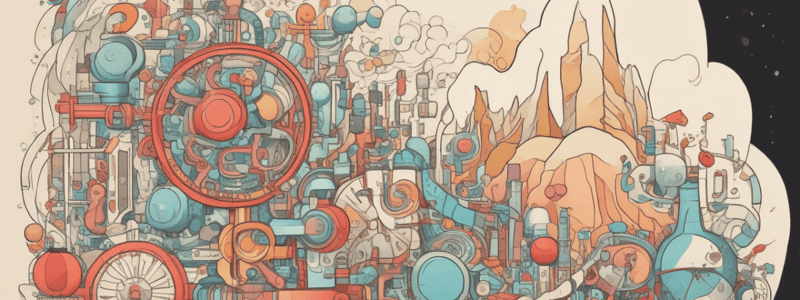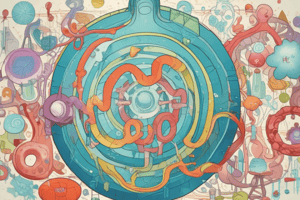Podcast
Questions and Answers
Where does catabolism of protein occur?
Where does catabolism of protein occur?
- Adipose tissue
- Liver
- Skeletal muscle
- Gastrointestinal tract (correct)
What is the result of protein catabolism?
What is the result of protein catabolism?
- Release of insulin and growth hormone
- Hydrolysis of peptide bonds (correct)
- Synthesis of peptide bonds
- Absorption of amino acids into the circulation
What is the approximate half-life of a body protein?
What is the approximate half-life of a body protein?
- 160 days
- 80 days (correct)
- 120 days
- 40 days
What is the daily total protein turnover in a healthy adult?
What is the daily total protein turnover in a healthy adult?
What percentage of protein synthesis is used for the synthesis of N-compounds?
What percentage of protein synthesis is used for the synthesis of N-compounds?
Which amino acid is used to synthesize nitric oxide?
Which amino acid is used to synthesize nitric oxide?
What is the fate of absorbed amino acids?
What is the fate of absorbed amino acids?
What percentage of protein synthesis is oxidized to provide energy?
What percentage of protein synthesis is oxidized to provide energy?
Where does ammonia detoxification mainly occur?
Where does ammonia detoxification mainly occur?
What is the nitrogen content of urea?
What is the nitrogen content of urea?
What is the result of a complete loss of enzyme in inherited diseases of the urea cycle?
What is the result of a complete loss of enzyme in inherited diseases of the urea cycle?
What induces the enzymes of urea synthesis?
What induces the enzymes of urea synthesis?
What is the byproduct of glutaminase action on glutamine?
What is the byproduct of glutaminase action on glutamine?
What is the purpose of the urea cycle?
What is the purpose of the urea cycle?
What is the result of partial loss of enzyme in inherited diseases of the urea cycle?
What is the result of partial loss of enzyme in inherited diseases of the urea cycle?
What is the precursor of urea in the urea cycle?
What is the precursor of urea in the urea cycle?
What is the function of transamination?
What is the function of transamination?
Which enzyme is involved in the deamination of glutamate?
Which enzyme is involved in the deamination of glutamate?
What is the cofactor required for transamination reactions?
What is the cofactor required for transamination reactions?
What percentage of nitrogen in the body is found in proteins?
What percentage of nitrogen in the body is found in proteins?
What is the byproduct of deamination reactions?
What is the byproduct of deamination reactions?
What is the term for the removal of the amino group (-NH) of an amino acid?
What is the term for the removal of the amino group (-NH) of an amino acid?
What is the total amount of nitrogen in a 70kg male?
What is the total amount of nitrogen in a 70kg male?
What is the clinical characterization of ammonia toxicity?
What is the clinical characterization of ammonia toxicity?
What is the number of essential amino acids that must be provided in the diet?
What is the number of essential amino acids that must be provided in the diet?
What percentage of the amino acid pool is made up of glutamine, alanine, proline, and glycine?
What percentage of the amino acid pool is made up of glutamine, alanine, proline, and glycine?
Which pathway is involved in the synthesis of amino acids with 4 and 5 carbon atoms?
Which pathway is involved in the synthesis of amino acids with 4 and 5 carbon atoms?
What is the result of the transamination reaction?
What is the result of the transamination reaction?
Which of the following amino acids is semi-essential?
Which of the following amino acids is semi-essential?
What is the end product of the urea cycle?
What is the end product of the urea cycle?
Which amino acid is converted to pyruvate during catabolism?
Which amino acid is converted to pyruvate during catabolism?
What is the byproduct of the removal of the amino group from an amino acid?
What is the byproduct of the removal of the amino group from an amino acid?
Phenylketonuria (PKU) is characterized by a deficiency of which enzyme?
Phenylketonuria (PKU) is characterized by a deficiency of which enzyme?
What is the primary clinical manifestation of Phenylketonuria (PKU)?
What is the primary clinical manifestation of Phenylketonuria (PKU)?
How is Phenylketonuria (PKU) typically diagnosed?
How is Phenylketonuria (PKU) typically diagnosed?
What is the primary function of insulin and growth hormone in the body?
What is the primary function of insulin and growth hormone in the body?
What is the building block of protein structure?
What is the building block of protein structure?
What type of amino acids must be supplied by the diet?
What type of amino acids must be supplied by the diet?
What is a potential consequence of untreated Hyperammonemia?
What is a potential consequence of untreated Hyperammonemia?
Where does the synthesis of urea occur?
Where does the synthesis of urea occur?
What is the primary effect of Phenylketonuria (PKU) on brain development?
What is the primary effect of Phenylketonuria (PKU) on brain development?
Flashcards are hidden until you start studying
Study Notes
Metabolism of Protein
- Catabolism of protein occurs in the gastrointestinal tract and involves the breakdown of peptide bonds into free amino acids by proteases and peptidases.
- The released amino acids are absorbed into the circulation and used by tissues, such as skeletal muscle, adipose tissue, and liver, with the help of insulin and growth hormone.
Dietary Proteins and Amino Acids
- Dietary proteins are digested in the stomach and intestine, releasing amino acids into the bloodstream.
- There are 20 amino acids, which are classified into essential and non-essential amino acids.
- Essential amino acids (9) must be supplied by the diet, while non-essential amino acids can be synthesized by the body.
Amino Acid Functions
- Amino acids are used for protein synthesis, N-compound synthesis, and energy production.
- They are also used for the synthesis of signaling molecules, such as nitric oxide and hydrogen sulfide.
Urea Synthesis and Ammonia Metabolism
- Urea synthesis occurs exclusively in the liver and is a vital process for removing excess nitrogen from the body.
- The urea cycle involves the conversion of ammonia to urea, which is then excreted in the urine.
- Ammonia toxicity can lead to serious clinical symptoms, including vomiting, lethargy, and mental retardation.
Regulation of Urea Synthesis
- Urea synthesis is regulated by protein diet, with high protein diets inducing the enzymes and low protein diets or starvation repressing them.
- Inherited diseases of the urea cycle can lead to hyperammonemia, which can be fatal if left untreated.
Transamination and Deamination
- Transamination involves the transfer of the amino group from one amino acid to another.
- Deamination involves the removal of the amino group from an amino acid, resulting in the release of free ammonia.
Nitrogen Metabolism
- The total amount of nitrogen in the body is approximately 2.0 kg (3% of body weight).
- Proteins are the major nitrogen-containing compounds in the body, accounting for 90% of the total nitrogen.
Amino Acid Metabolism Diseases
- Phenylketonuria (PKU) is an inherited metabolic disorder caused by a deficiency of phenylalanine hydroxylase, leading to the accumulation of phenylalanine and its toxic metabolites.
- PKU can result in abnormal brain development and intellectual disability if left untreated.
Studying That Suits You
Use AI to generate personalized quizzes and flashcards to suit your learning preferences.





